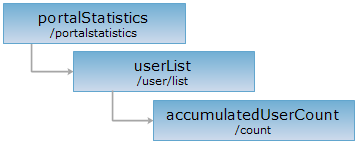
<portalStatistics_uri>/user/list/count[.<format>]
accumulatedUserCount is the resource that records the iPortal accumulated user count during a period of time. GET request returns all of the iPortal's accumulated user count if there's no parameter of time and returns the count information during a period of time if the parameter of time has been transmitted
Supported Methods:
Supported output formats: rjson, json, html, xml.

Implements the HTTP request on the following URI, where supermapiportal is the server name, with rjson being the output format.
http://supermapiportal:8090/iportal/manager/portalstatistics/user/list/count.rjson
GET: Gets the accumulated user count in a period of time.
If the parameter has not been set, all of the iPortal's accumulated user count will be returned. If the parameter has been set, an increased accumulated user count in a period of time will be returned. Request parameter shall be contained within URI.
| Name | Type | Description |
| startTime | Long | The start time of accumulated user count record. If not a positive number, it will be queried from the earliest record. The value is the milliseconds from 00:00:00 GMT January 1, 1970. |
| endTime | Long | The end time of the accumulated user count record. If it's null or not a positive number, use the server time as the end time. The value is the milliseconds from 00:00:00 GMT January 1, 1970. |
The returned rjson format representation after implementing the GET request on the accumulatedUserCount resource http://localhost:8090/iportal/manager/portalstatistics/user/list/count.rjson is as follows:
2
To get changes information of accumulated user count during a period of time, set parameters as: startTime=1492063745780&endTime=1492063745789&intervalType=DAY. The returned rjson format representation after implementing the GET request on the accumulatedUserCount resource http://localhost:8090/iportal/manager/portalstatistics/user/list/count.rjson?startTime=1492063745780&endTime=1492063745789 is as follows:
1
Asks for the response identical to the one that would correspond to a GET request, but without the response body. This is useful for retrieving meta-information contained in response headers, without having to transport the entire content. The meta-information includes the media-type, content-encoding, transfer-encoding, content-length, etc.
HEAD request can be used to check whether the accumulatedUserCount resource exists, or whether the the client has the permission to access it. It can also determine if the accumulatedUserCount resource supports an output format <format> if performed on a URI with .<format> included.